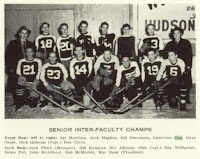© 2014, Christian Cassidy
May 6, 1950, Winnipeg Tribune
Around 100,000 people, 40,000 in Winnipeg and 60,000 from the rest of the province, were displaced form their homes as the Red created a lake that covered more than 600,000 square miles, or 1,555,000 square kilometres, of land. It was the largest mass evacuation in Canada's history.
Thousands of people lost their homes, jobs, and businesses, or had their farms and livestock wiped out. Some pegged the damage estimates at $50 million, which is over $500 million in today’s dollars.
For weeks after, donations of money, equipment, food, clothing and blankets arrived from places as far away as California and Britain via the Red Cross. Emperor Haile Selassie of Ethiopia donated $3,000.
Incredibly, despite all of the damage, the flood was responsible for only two deaths in Manitoba.
April 22, 1950, Winnipeg Free Press
On April 21, 1950, he and his 14-year-old son, Albert, were trying to cross the swollen Marsh Creek that ran through their property. The boat capsized and Roland Sicotte drowned. Albert managed to save himself.
Sicotte left a widow and seven children ranging in age from a newborn baby to fourteen years.
Winnipeg's only fatality was Lawson Alfred Ogg, 26, of 873 Sherburn Street.
Ogg was born in Winnipeg, the only child of Gregor and Susan Ogg. The couple moved to the house on Sherburn Street when Lawson was an infant and he attended Greenway School, General Wolfe School, and Daniel McIntyre Collegiate before going on to the University of Manitoba to study accounting.
In his teenage years, Ogg played lacrosse with the Orioles Community Club, and while at U of M he played for the faculty hockey team.
World War II interrupted Ogg's studies. He went overseas with the Royal Winnipeg Rifles and reached the rank of Lieutenant. Upon his return, he moved back in with his parents and went back to school. He spent 1948 - 49 as an articling student.
Instead of working for a large company, like the one he articled with, Ogg decided to open a firm of his own called L. A. Ogg and Company.
Ogg was a member of the Optimists Club. During the 1950 flood, they, like many community organizations, sent members out to lay sandbags in the most impacted areas of the city.
On the evening of Saturday, May 6, a handful of Optimists were working at the home of Dr. A. V. Johnson at 357 Kingston Crescent. At around 7:00 p.m. the dike behind the home breached and swept Ogg and G. F. Schoales of 128 Garfield Street into the basement of the house. Ogg didn't make it out.
May 22, 1950, LIFE Magazine (Source)
Lawson Alfred Ogg was buried in Elmwood Cemetery on Wednesday May 10, 1950.
April 22, 1950, Winnipeg Free Press
The only U.S. casualty that I could find related to the 1950 flood was Howard Bjorgaard, 27, a farmer near Argyle, Minnesota. He died when the Snake River flooded his land and he came in contact with a downed power line.


















2 comments:
Wow, I can't imagine making it through WWII overseas, coming back and re-integrating into society only to die a few years later sandbagging someone's house. How tragic.
great.
Post a Comment